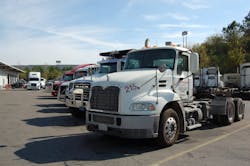Kurt Nantkes is senior vice president of sales for Zonar Systems, responsible for customer satisfaction and sales success in North American markets. He also works collaboratively with the company’s product development team and customer care division on implementation, support, and ongoing maintenance issues. In this guest column, Nantkes offers some advice on how to gain better control truck maintenance costs.
Maintaining and operating a commercial truck over the course of a year is a pricey endeavor – in fact, the average yearly cost to keep a truck on the road is $180,000, which is about the same price for a new home.
Of that, the average cost of repairs and maintenance for a single truck is $15,000 year.
With the right processes in place, though, such costs can decline dramatically; but without the proper due diligence and technology, that number can easily spiral out of control.
With commercial trucks traveling hundreds of thousands of miles every year, and the cost per mile nearly $1.50, managing and maintaining a strict budget can seem like a daunting task.
Thus truck owners must think strategically about the best ways to stay ahead of – and even anticipate – maintenance before they become bigger and costlier issues.
Here are several strategy tips to help reduce unexpected downtime and keep trucks on the road:
- Review Your Current Best Practices: Before you spend even a dollar on costly new tech or third party consultants, it’s important to evaluate your current operations and take stock of where you’re financially. If you look at your annual maintenance and repair costs and get sticker shock, it might be time for you to look at new ways to manage your fleets. If you’re coming in at a reasonable level, it might not be worth the extra time and investment to try and lower costs even further. The real lesson here: before you make any drastic changes, carefully evaluate everything that you’re already doing. More often than not there are simple ways to cut costs; there’s no reason to reinvent the wheel if things are already running smoothly.
- Identify Areas of Weakness: Whether it’s an operational problem like not completing thorough pre-trip inspections, or it’s a mechanical issue, such as inadequate tire pressure, brake or electrical malfunctions, the vast majority of failures can (and should) be identified before they become bigger problems. With the implementation of proper inspection tools and practices, you can generally stay on top of things before they become a larger issue. For example: Are you aware of the inspection process for your organization, state or federal guidelines? Are there times or dates, or roads and locations, where repairs seem to be needed the most? The sooner you’re able to figure out where improvements can be made, the quicker you can predict and address them to make changes.
- Find Solutions that Work for You – Now and in the Future: Technology can be a great aid in terms of gaining a “heads up” on potential maintenance issues. For example our patented Electronic Verified Inspection Reporting (EVIR) system is a visual inspection system that is designed to capture, transmit and record inspection and maintenance data in real-time. If something doesn’t look right or isn’t up to standards, drivers will know immediately and can course correct before things take a turn for the worse. With the ability to plan for repairs more effectively, you can avoid larger, more costly issues and increase vehicle uptime.
- Pick Your Solutions, Monitor Results: Once the new processes are in place and products are installed, it’s important to closely monitor results and keep an eye on how these changes are working out. The best way to track the impact these changes are making is to set up regularly scheduled check-points throughout the year. Are you seeing improvements and cost savings after three months? After six months?
If you’re able to follow these simple steps, you should be able to stay ahead of the curve and save some money in the long run. Although it can be daunting at first glance, some initial, upfront investment could save thousands of dollars over the course of a single trucking season.

